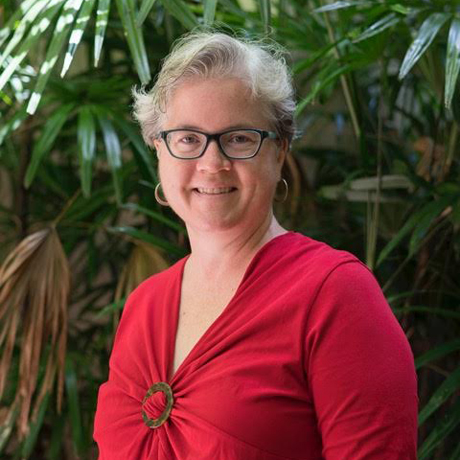
(photo by Jonel Jugueta)
Associate Professor of Art History
Office Room 223 / lingley@hawaii.edu
RESEARCH AREAS - Social history of art in medieval China: Buddhism, patronage, gender, dress, ethnicity, the Silk Road
Medieval Buddhist of the Day (blog)
BIO
Kate Lingley (Ph.D. University of Chicago 2004) is Associate Professor of Chinese Art History in the Art and Art History department at the University of Hawai’i at Mānoa. Her research focuses on Buddhist votive sculpture of the Northern and Southern Dynasties period, with a particular interest in the social history of religious art. She is interested in the social significance of representation, religious practice, and identity, especially gender and ethnic identity, in a period of rapid social change in which non-Chinese peoples ruled much of North China. This has led to a further interest in Chinese identity in a range of historical periods. The relationship between dress and identity, especially along the Silk Road, has given rise to a second body of research on dress and textiles in medieval China. Her articles in these areas have been published in Asia Major, Ars Orientalis, Early Medieval China, and Archives of Asian Art, among others. She was a contributor and the early China editor for the revised Oxford Asian Art Online, and is the volume coeditor (with Matthew Canepa) for the Bloomsbury Cultural History of Asian Art, vol. 1 (500 BCE - 600 CE). Professor Lingley is currently working on a book manuscript on the lives of Buddhist women in medieval China, as seen through the votive monuments they dedicated, and an edited collection on the epigraphic evidence for women’s role in early Buddhism across Asia. Her teaching covers the range of Chinese art history from the Neolithic to the present day, plus the art of the European Middle Ages.
EDUCATION
Ph.D. in Art History / University of Chicago / 2004
M.A. in Art History / University of Chicago / 1998
B.A. in Anthropology / Harvard University / 1994
SELECTED PUBLICATIONS
• “A Hybrid Inscription at Shuiyusi: The Buddhist Funerary Record.” In Sun Yinggang 孫英剛 ed., 佛教史研究 (Studies in the History of Buddhism) 3, 2019, 111-132.
• “Kinship and Commemorative Practices in Early Medieval Buddhist Art.” In Wu Hung and Paul Copp, eds., Refiguring East Asian Religious Art: Buddhist Devotion and Funerary Practice. Chicago: Center for the Art of East Asia, University of Chicago; and Art Media Resources, 2019, 106-121.
• 水浴寺石窟における寄進と記念 (Patronage and Memory at the Shuiyu Si Cave Temple.) In Japanese. In Hamada Tamami 濱田瑞美, ed., アジア仏教美術論集、東アジア I:後漢、三國、南北朝 (Asian Buddhist Art Anthology, East Asia vol. 1: The Later Han, the Three Dynasties and the Southern and Northern Dynasties). Tokyo: 中央公論美術出版 (Chuo Koron Bijutsu Shuppan), 2017, 539-574.
• “Silk Road Dress in a Chinese Tomb: Xu Xianxiu and sixth-century cosmopolitanism.” In The Silk Road, vol. 12, 2014.
• “Lady Yuchi in the First Person: Patronage, History, and Voice in the Guyang Cave.” Early Medieval China vol. 18 (2012).
• The Reformer’s Brush: Modernity and Traditional Media in China. Honolulu: University of Hawai’i Art Gallery, 2011.
• “The Patron and the Community in Eastern Wei Shanxi: the Gaomiaoshan Cave Temple Yi-society.” Asia Major vol. 23, part I, 2010.
• “Naturalizing the Exotic: On the changing meanings of ethnic dress in medieval China.” Ars Orientalis vol. 38, 2010.
• “A Brief History of Ethnic Costume in Premodern China.” In Writing with Thread: Traditional Textiles of Southwest Chinese Minorities. Honolulu: University of Hawai'i Art Gallery, 2008.
• Excelling the Work of Heaven: Personal Adornment from China. Honolulu: University of Hawai’i Art Gallery, 2007.
•“The Multivalent Donor: Zhang Yuanfei at Shuiyusi.” In Archives of Asian Art, v. 56, 2006.
• 2009 Chancellor’s Citation for Meritorious Teaching, University of Hawai‘i at Manoa
COURSES TAUGHT
ART 175 (History of Global Art I)
ART 371 (Art of Medieval Europe)
ART 385 (Art and Culture of Early China)
ART 386 (Art and Culture of Later China)
ART 395 (Art-Historical Methodology)
ART 400C (Sculpture of China)
ART 486 (Traditional Chinese Painting)
ART 487 (Modern and Contemporary Art of China)
ART 688 (Topics in the Art of China)
Past topics include:
Fall 2004: Buddhist Sculpture of Medieval China
Fall 2005: Representing Ethnic Identity in Premodern China
Fall 2006: Dunhuang Art and Culture
Spring 2008: Discourses of Art in 20th-century China
Fall 2008: Tomb Sculpture and the Spaces of Funerary Art
Spring 2011: Chinese Painting and Calligraphy, 1840-1960
Spring 2014: Art on the Margins of the Chinese Empire
Fall 2018: Contemporary Art and the Chinese City
